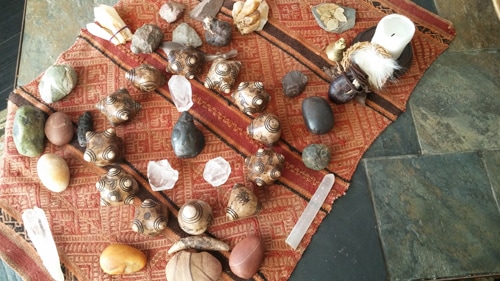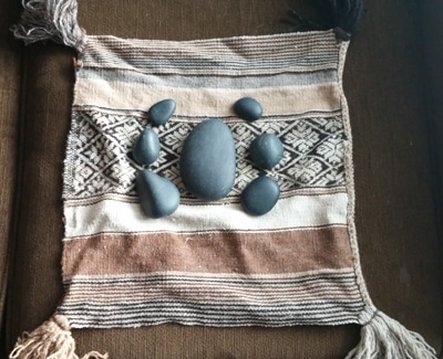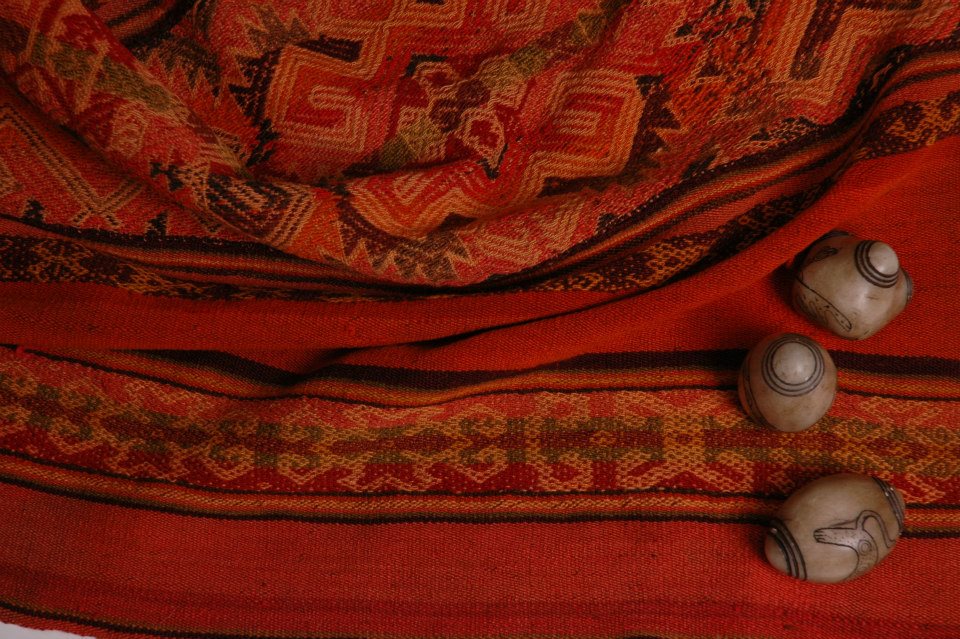 Open Mesa
Open Mesa The Andean Medicine Bundle or Mesa
Shaman’s everywhere connect with the spirits of the earth, with nature, calling upon these unseen forces to assist them in their work. To help facilitate this connection, some form of a medicine bundle is created by the shaman.
For North American First Nations people, the medicine bundle is considered a very precious possession which represents a person's spiritual life, and may possess powers for protection and healing. As the owner grows older, more items may be added to it. Personal medicine bundles are usually buried with the owner, or passed on to a friend upon the owner's death. Each bundle contains a varied collection of objects and representations of spiritual significance, from animal skins and effigies to ceremonial pipes. Most medicine bundles have been passed down from one keeper to another over such a long span of time that their origins have become shrouded in mystery and myth.
The Mesa
In the Andean Medicine Path we address the medicine bundle of the Andean shamans which is known as a Mesa. The Mesa is a shamanic altar containing ritually empowered objects, which are aesthetically arranged on a sacred textile to reflect the system of medicine work employed by its carrier. These objects are arranged in a spatial configuration to assist in attainment of physical, emotional, spiritual and mental integration through the advancement of consciousness.
Although there are universal symbols and objects common to many mesas of the Andes, the pieces placed upon them are ultimately unique to the Mesa carrier.
When a Mesa is opened (ceremonially activated) the distinction between the symbol and that which the symbol represent is dissolved. The objects arranged upon the mesa become the mountains, the rivers, totem animal, or the empowered representation of the shaman’s own healing.
Exactly when and where the Mesa originated is not known with certainty. Anthropologists acknowledge that shamanism is a universal phenomenon among primitive as well as modern human societies, and may have its origins as far back as 40,000 years ago. Extensive research has traced shamanic technology in Peru back at least 4000 years but we can speculate that the origins of the Mesa could go back as far as 8,000 BC to the early inhabitants of Peru’s Central Highlands during the Early Archaic Period. Although the Mesa’s date of origin is ambiguous, it is clear that it has accrued a mass of wisdom found only through a process of substantial refinement. As such, there is much that can be learned from the rich mythological belief system and cosmology of the Mesa as a visionary instrument of sacred technology.
The woven textile upon which the contents of the mesa are arranged is called a Mestana. The Mestana is traditionally the cloth woven by a woman to wrap her newborn child in. If and when the child shows a giftedness that would place them in an apprenticeship with a shaman, the birthing cloth is given to the child to hold the medicine that the child is spiritually giving birth to. Since many more Mastanas are woven than are used by indigenous shamans, the markets in Peru are a ready source of both new and second-hand cloths. The Mestana is usually about 30” by 30” and are some of the most beautiful weavings you will find anywhere. As the cloth upon which the sacred objects of power of the shaman are placed, the Mestana itself is a sacred object and is treated with utmost respect.
The most common objects in the Andean Mesa are stones which the shaman has collected. The stones present themselves to the shaman as he/she is out in nature and reflect the power of the particular place in which they are found. When picked up and ceremonially added to the Mesa they then become a Kuya (or Khuya) which means Beloved. The shaman then builds a relationship with the Kuya; discovering the innate power of the Kuya and the relationship of power that the Kuya has with the landscape in which was found. As the relationship develops, the shaman can then call upon both the power residing in the Kuya and the power of the landscape from which the Kuya originated to help them with their work.
Shaman’s everywhere connect with the spirits of the earth, with nature, calling upon these unseen forces to assist them in their work. To help facilitate this connection, some form of a medicine bundle is created by the shaman.
For North American First Nations people, the medicine bundle is considered a very precious possession which represents a person's spiritual life, and may possess powers for protection and healing. As the owner grows older, more items may be added to it. Personal medicine bundles are usually buried with the owner, or passed on to a friend upon the owner's death. Each bundle contains a varied collection of objects and representations of spiritual significance, from animal skins and effigies to ceremonial pipes. Most medicine bundles have been passed down from one keeper to another over such a long span of time that their origins have become shrouded in mystery and myth.
The Mesa
In the Andean Medicine Path we address the medicine bundle of the Andean shamans which is known as a Mesa. The Mesa is a shamanic altar containing ritually empowered objects, which are aesthetically arranged on a sacred textile to reflect the system of medicine work employed by its carrier. These objects are arranged in a spatial configuration to assist in attainment of physical, emotional, spiritual and mental integration through the advancement of consciousness.
Although there are universal symbols and objects common to many mesas of the Andes, the pieces placed upon them are ultimately unique to the Mesa carrier.
When a Mesa is opened (ceremonially activated) the distinction between the symbol and that which the symbol represent is dissolved. The objects arranged upon the mesa become the mountains, the rivers, totem animal, or the empowered representation of the shaman’s own healing.
Exactly when and where the Mesa originated is not known with certainty. Anthropologists acknowledge that shamanism is a universal phenomenon among primitive as well as modern human societies, and may have its origins as far back as 40,000 years ago. Extensive research has traced shamanic technology in Peru back at least 4000 years but we can speculate that the origins of the Mesa could go back as far as 8,000 BC to the early inhabitants of Peru’s Central Highlands during the Early Archaic Period. Although the Mesa’s date of origin is ambiguous, it is clear that it has accrued a mass of wisdom found only through a process of substantial refinement. As such, there is much that can be learned from the rich mythological belief system and cosmology of the Mesa as a visionary instrument of sacred technology.
The woven textile upon which the contents of the mesa are arranged is called a Mestana. The Mestana is traditionally the cloth woven by a woman to wrap her newborn child in. If and when the child shows a giftedness that would place them in an apprenticeship with a shaman, the birthing cloth is given to the child to hold the medicine that the child is spiritually giving birth to. Since many more Mastanas are woven than are used by indigenous shamans, the markets in Peru are a ready source of both new and second-hand cloths. The Mestana is usually about 30” by 30” and are some of the most beautiful weavings you will find anywhere. As the cloth upon which the sacred objects of power of the shaman are placed, the Mestana itself is a sacred object and is treated with utmost respect.
The most common objects in the Andean Mesa are stones which the shaman has collected. The stones present themselves to the shaman as he/she is out in nature and reflect the power of the particular place in which they are found. When picked up and ceremonially added to the Mesa they then become a Kuya (or Khuya) which means Beloved. The shaman then builds a relationship with the Kuya; discovering the innate power of the Kuya and the relationship of power that the Kuya has with the landscape in which was found. As the relationship develops, the shaman can then call upon both the power residing in the Kuya and the power of the landscape from which the Kuya originated to help them with their work.
 A Salka Mesa
A Salka Mesa This relationship of power develops through shamanic journeying with the Kuya deep into the landscape that sourced the Kuya and through the creation of cekes which are energetic lines of connection between the Kuya and the shaman’s medicine body. These cekes are highways of information through which communication travels in two directions: between the shaman and the Kuya in which the Kuya is informed of all that resides within the shaman’s medicine body and the shaman is informed of all the levels of power that the Kuya has within its medicine body. It is a co-creative relationship which takes concerted effort on the part of the shaman to develop but which ultimately becomes the basis for all of their healing abilities. The key to a shaman’s power are in their relationships with the natural world and their ability to call upon those relationships to assist them in their work.
Ultimately the Mesa acts as the shaman’s tool, an instrument of sacred technology, which is used to access and cultivate an intimate relationship with Spirit, which in its very nature is mystery. The Mesa thus can be seen as a reflection of the personal cosmology of the shaman. The objects within the Mesa describe the relationships of power of the shaman and as such describe the beliefs of the shaman. Over time, one’s cosmology can change and develop new order. This will then be reflected in the Mesa as the shaman removes that which no longer serves them and adds the new focus of their power. When the shaman finds their power faltering, they need look no further than their Mesa to discover where a relationship of power no longer serves them. It can be that the lack of relationship stems from the shaman’s inattentiveness to the source of his power or it can be that that power is no longer available to him/her. As these changes and cycles naturally occur, it can be seen that the Mesa is a truly organic tool that works with the attention given it and grows and changes with the growth and change of the shaman.
Though the Andean Mesa consists primarily of stones, other items may also be found in it. Sometimes the shaman will come across naturally occurring crystals on the mountains and these are highly valued and placed in the mesa. The crystals can transmit very clear messages from the mountain itself and are considered great sources of power. Religious fetishes and cultural items are sometimes found within the mesa as they reflect the personal healing and spiritual journey of the shaman. Every item relates to power in some way and is never there just for sentimental value.
Ultimately the Mesa acts as the shaman’s tool, an instrument of sacred technology, which is used to access and cultivate an intimate relationship with Spirit, which in its very nature is mystery. The Mesa thus can be seen as a reflection of the personal cosmology of the shaman. The objects within the Mesa describe the relationships of power of the shaman and as such describe the beliefs of the shaman. Over time, one’s cosmology can change and develop new order. This will then be reflected in the Mesa as the shaman removes that which no longer serves them and adds the new focus of their power. When the shaman finds their power faltering, they need look no further than their Mesa to discover where a relationship of power no longer serves them. It can be that the lack of relationship stems from the shaman’s inattentiveness to the source of his power or it can be that that power is no longer available to him/her. As these changes and cycles naturally occur, it can be seen that the Mesa is a truly organic tool that works with the attention given it and grows and changes with the growth and change of the shaman.
Though the Andean Mesa consists primarily of stones, other items may also be found in it. Sometimes the shaman will come across naturally occurring crystals on the mountains and these are highly valued and placed in the mesa. The crystals can transmit very clear messages from the mountain itself and are considered great sources of power. Religious fetishes and cultural items are sometimes found within the mesa as they reflect the personal healing and spiritual journey of the shaman. Every item relates to power in some way and is never there just for sentimental value.

